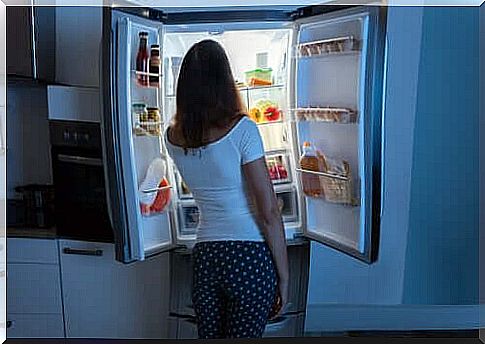Do You Suffer From The Night-seal Syndrome?

The night-seal syndrome is classified as either an eating disorder or a sleep disorder. The category into which it falls depends on whether the individual is awake or not when he eats.
In both cases, this syndrome is defined as the act of overeating large amounts of food after dinner or in the middle of the night, with a preference for high-calorie and carbohydrate-rich foods.
The German researchers Zwaan, Muller, Allison, Brahler and Hilbert estimated in 2014 that the night-seal syndrome (NES) affects 1.5% of the population and has serious health consequences.
In this article, we will talk more about the symptoms, causes and treatment of NES. It is a rare syndrome, but it is serious enough to deserve our attention.
What is Night Seal Syndrome (NES)?
Dr. Albert Stunkard was the first to talk about the Night Seal Syndrome (NES) in 1955.
The Diagnostic and Statistical Manual of Mental Disorders (DSM-5) classifies it under Other Specified Feeding or Eat Disorder (OSFED).
Sleep-related eating disorder is similar. The difference between the two is that people with NES are awake when they eat. People with sleep-related eating disorders actually eat in their sleep.

When the individual sleeps while eating and is not aware of what he is doing, we are dealing with a subtype of sleepwalking. It happens during REM sleep and is characterized by very deep sleep cycles.
An individual with this disorder will get up and eat compulsively without realizing it. The person may appear awake and may open the fridge, chew and swallow.
Like sleepwalkers, sleepwalkers have no idea what they are doing and do not remember anything the next morning.
When it comes to night-seal syndrome, however, the person is awake all the time and remembers everything. This is also a case of compulsive eating, but it has some degree of voluntariness.
What are the symptoms of the night seal syndrome?
The night-seal syndrome is easy to diagnose due to frequent episodes of compulsive eating during the night or before bedtime. In other words, it is a kind of food addiction.
Although the victims do not want to eat or try to lose weight, they eat at night. Although it is not easy for them to acknowledge or discover their problems, they are awake and aware of their actions.
On the other hand, sleep-related eating disorders are much more difficult to diagnose. What usually happens is that a friend or family member will catch the person and that he or she will start gaining weight without knowing why.
Another possibility is that they notice that things disappear from the fridge and no one remembers that they took anything.
However, since people with this problem eat during very deep sleep, it is very unlikely that they will realize that they have a problem.
Both cases are characterized by excessive and compulsive eating after dinner or in the middle of the night.
Psychologists will only give this particular diagnosis after ruling out other psychological or psychiatric problems.
What causes NES and sleep-related eating disorders?
In the case of night-seal syndrome (NES), the individual uses food to escape depression and anxiety. Eating is a mechanism for dealing with the problem. It develops just like food addiction.
People with NES feel an urgent need to eat and they can not calm down until they have done so.
Sleep-related eating disorder (SRED), on the other hand, is caused by a problem that occurs when people wake up. They are not ready to wake up, but when they do, their motor system for voluntary movement is activated.
This in turn triggers “automated” actions or well-learned behaviors, such as walking, talking and eating. This is why most people with SRED are not aware of their behavior.
They may wake up while eating without understanding what they are doing or how they got to the fridge.
In all cases, these eating disorders at night are more common in people with obesity. They usually have something to do with hormone imbalance (melatonin and cortisol) and neurotransmitters such as serotonin.
Consequently, various studies show that certain drugs can effectively treat these disorders.
These studies specifically studied drugs such as selective serotonin reuptake inhibitors (SSRIs), melatonin (the sleep hormone) and drugs that reduce the stress response (Zapp, Fischer and Deuschle, 2017).
In general, disturbances in sleep patterns and circadian rhythms tend to lead to eating at night.
Although we do not have many studies on the causes of these disorders, experts assume that factors such as anxiety, stress, obesity and circadian rhythm disorders are the most likely causes.

Treatment against NES and SRED
Both NES and SRED require an interdisciplinary treatment method.
Dietitians are committed to helping patients lose weight. Psychiatrists prescribe all the necessary drugs, and psychologists help them deal with their problems on a behavioral, emotional and cognitive level.
It is important to remember that the physical consequence of weight gain is not the only side effect. People with these disorders are dealing with high levels of anxiety and depression.
They need psychological treatment to help them overcome their problems.
On the other hand, there are also steps they can take to break the cycle of binge eating.
Locking the refrigerator, locking the bedroom door or coming up with something to help them wake up if they get out of bed can be effective measures.
If the problem is an eating disorder, patients will need therapy that treats insomnia. This is because eating helps them fall asleep.
If they are not allowed to eat before going to bed, they may have trouble falling asleep.
However, people who suffer from an eating disorder at night must make a series of changes in their lives to overcome their problems.









